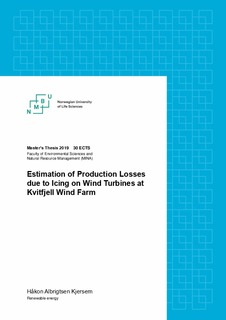| dc.contributor.advisor | Gravdahl, Arne Reidar | |
| dc.contributor.author | Kjersem, Håkon Albrigtsen | |
| dc.coverage.spatial | Norway, Oppland, Ringebu, Fåvang, Kvitfjell | nb_NO |
| dc.date.accessioned | 2019-08-15T11:27:37Z | |
| dc.date.available | 2019-08-15T11:27:37Z | |
| dc.date.issued | 2019 | |
| dc.identifier.uri | http://hdl.handle.net/11250/2608486 | |
| dc.description.abstract | Wind farms in cold climates are known for their challenge’s with lowered performance due to icing on wind turbine blades, but there is little knowledge around the correlation between wind, ice and energy production which is of great importance for investors. To increase accuracy and knowledge of production losses from icing, a method for ice modelling based on measured data from met mast is established.
In this thesis the production losses due to icing on wind turbine blades at Kvitfjell wind farm is investigated in the period of July 2014 – January 2016 through use of CFD-simulation. Two ice scenarios are established, and the largest production losses is found to be 9,50 % of total energy production in the worst-case scenario. The more likely scenario is estimated to have a production loss at 4,75 %.
There are uncertainties around how well the ice model manages to capture the actual ice conditions as there may be large variation in atmospheric icing within the wind farm and it is assumed a flat reduction in power curve. Implementation of more data would increase the accuracy of the model as well as measurements of cloud frequency, ice shape- and type. | nb_NO |
| dc.description.abstract | Vindparker i kaldt klima er kjent for sin utfordring med redusert ytelse grunnet ising på vindturbinblad, men det er til tross lite kunnskap rundt sammenhengen mellom vind-, is- og energiproduksjon, som er av stor betydning for investorer. For å øke nøyaktigheten og kunnskapen om produksjonstap fra ising, er en metode for is modellering basert på målte data fra met mast etablert.
I denne oppgaven undersøkes produksjonstapene som følge av isdannelse på vindturbinblader ved Kvitfjell vindkraftverk i perioden juli 2014 - januar 2016 ved bruk av CFD-simulering. To is-scenarioer er etablert, og det største produksjonstapet er funnet til å være 9,50 % av den samlede energiproduksjonen i det verste utfalls-scenarioet. Det mer sannsynlige scenarioet er beregnet til å ha et produksjonstap på 4,75 %.
Det er usikkerhet rundt hvor godt is-modellen klarer å fange de faktiske isforholdene, da det kan være store variasjoner i atmosfærisk ising innad vindparken, og det antas en flat reduksjon i effektkurven. Implementering av mer data vil øke nøyaktigheten av modellen, så vel som målinger av skyforekomst, is-form og -type. | nb_NO |
| dc.language.iso | eng | nb_NO |
| dc.publisher | Norwegian University of Life Sciences, Ås | nb_NO |
| dc.rights | Attribution-NonCommercial-NoDerivatives 4.0 Internasjonal | * |
| dc.rights.uri | http://creativecommons.org/licenses/by-nc-nd/4.0/deed.no | * |
| dc.subject | CFD | nb_NO |
| dc.subject | Wind power | nb_NO |
| dc.subject | Cold climate | nb_NO |
| dc.title | Estimation of production losses due to icing on wind turbines at Kvitfjell wind farm | nb_NO |
| dc.type | Master thesis | nb_NO |
| dc.source.pagenumber | 52 | nb_NO |
| dc.description.localcode | M-FORNY | nb_NO |

